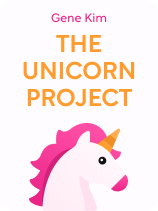

This article is an excerpt from the Shortform book guide to "The Unicorn Project" by Gene Kim. Shortform has the world's best summaries and analyses of books you should be reading.
Like this article? Sign up for a free trial here.
What is the book The Unicorn Project by Gene Kim about? How can employee autonomy make or break a company?
In The Unicorn Project, Gene Kim presents a fictional case study of a business that falls behind its competitors because of its soul-crushing work conditions. The result is a band of rebellious employees to figure out a new, more productive way of working.
Read below for a brief The Unicorn Project book overview to get the main ideas.
The Unicorn Project by Gene Kim
A modern company lives or dies by the efforts of the people it employs, and even a successful, long-lasting business can be undone by a toxic workplace culture. In The Unicorn Project book, published in 2019, Gene Kim argues that an organization is doomed if it fails to trust and empower its employees, focuses on assigning blame rather than solving problems, and stops anything from being accomplished by drowning every action in a mound of red tape. Once a business develops this kind of culture, it can either turn itself around or fade into irrelevance as rival companies outstrip it in the market.
The Unicorn Project presents a fictional case study of Parts Unlimited, a once-mighty auto parts manufacturer that’s fallen behind the times and its competitors, mainly because of the soul-crushing work conditions it’s allowed to develop in its IT department. When a technological initiative that’s crucial to the company’s success turns into a disaster, Parts Unlimited almost collapses until a band of rebellious programmers figure out a new, more productive way of working and put it into motion behind their executives’ backs.
Kim is the founder of the digital security company Tripwire, cofounder of the IT Process Institute, and a vocal proponent of the DevOps software development model. In 2013’s The Phoenix Project, written with coauthors Kevin Behr and George Spafford, Kim told the story of Parts Unlimited from the perspective of a company executive as he rescued its faltering IT department by better managing its production workflow. In The Unicorn Project, Kim tells the same story from a software developer’s point of view to highlight the characteristics of a healthy, creative workplace and what can be done to shift a company’s culture.
The Impossible Project
Kim’s narrative follows the story of Maxine Chambers, a lead developer in Parts Unlimited’s software development department within IT. Through Maxine’s eyes, Kim illustrates the characteristics of both unproductive and healthy workplace cultures, with an emphasis on how the former can be turned into the latter. In the story, Maxine goes from the frustration of being part of an ineffective department to joining a group of company rebels who secretly work to institute better practices, eventually setting an example for the rest of the company to follow.
Our story begins as Maxine finds out she’s been unjustly blamed for a payroll system failure. As punishment, she’s exiled to work on an online sales tool called the Phoenix Project that everyone in IT despises. Though management considers the Phoenix Project essential to dragging Parts Unlimited into the digital age, it’s been stuck in development hell for years. When Maxine arrives at her new workplace, the situation is even worse than she’d imagined.
The Phoenix Project office is a dismal cube farm where developers work in isolation from each other. The culture is one in which there’s no feedback, no visible progress, and no risks taken to foster innovation because people fear they’ll be punished if something goes wrong. While programmers develop separate Phoenix features, there’s no standard environment for developers to work in, no way to test the code they write, and no Phoenix documentation to help newcomers begin. Maxine’s initial task is to write that documentation, but she finds it impossible to even install a pre-release version of Phoenix on her laptop.
At a company meeting, the CEO announces that there will be no further delays in rolling the Phoenix Project out for the public—despite the fact that there hasn’t been a single successful test of the system. Everyone in IT knows that in its current state, Phoenix can’t possibly work, but rather than working toward a viable solution, IT’s development and operations divisions are at each other’s throats. Meanwhile, Maxine meets a sympathetic colleague named Kurt from quality assurance. He invites her to an after-hours meeting of coworkers who routinely bend and break company rules to actually get things done.
An Underground Movement
Through the secret group that Maxine joins, Kim gives the first glimpse of what a productive IT department looks like. Kurt’s rebels include people from Dev, Ops, and QA who willingly work together. In reaching out to help colleagues like Maxine, their collective mission is to undermine Parts Unlmited’s culture of division in which its departments compete for resources, protect their own interests, and lose sight of the needs of the business as a whole. Kim argues that the growth of a toxic company culture is self-inflicted—a company’s production workflow bogs down because management and workers allow it to happen.
At the moment, the rebel group is small, and there’s nothing they can do to save the Phoenix Project. Its deployment goes even worse than expected. Databases are corrupted, orders get lost, and even the company’s internal networks crash. The company executives who lobbied for the rollout try to fix the blame on IT while the departmental managers focus on self-protection instead of problem-solving. Meanwhile, IT can’t get anything done because every system change and bug fix has to go through a Kafkaesque approval process.
The Rebels Strike Back
The disruption caused by the Phoenix Project meltdown creates an opening for the rebels to expand their operations. By formalizing their behind-the-scenes network, Kurt and Maxine merge the functions of different departments to create a cycle of feedback and progress. They do this by self-organizing into a new team, tackling a system bottleneck that’s slowing Phoenix down, and eventually detaching that bottleneck from the Phoenix software altogether.
While IT scrambles to keep Phoenix working, Kurt lobbies for Maxine and the rebels to become a new product development team that incorporates testing into the development process instead of waiting to do it after the fact. This bypasses the complicated ticketing system that ostensibly lets IT track progress but, in practice, prevents work by segregating the steps of software creation between multiple departments. It’s a risky move to short-circuit Parts Unlimited’s bureaucracy that, if it fails, could get them all fired.
Maxine’s first mission is to salvage Data Hub, a patched-together legacy system that Phoenix relies on to pull customer and product information from separate databases spread throughout the network. Data Hub is slow and antiquated, but so many of the company’s systems run through it that replacing it would be a logistical nightmare. Though its deficiencies are a major bottleneck preventing Phoenix from working, Kim writes that upgrading and maintaining Data Hub has never received support from on high because management gives apps and features higher value than the underlying systems that support them.
Kurt’s rebels make it a priority to create a working environment that developers can use to test their changes to Data Hub. This new, slimmed-down test environment spreads through the rest of Dev and QA, whose members start working in conjunction with each other. They even rearrange their cubicles so developers and testers can work side by side, providing rapid feedback and speeding up their progress. Kim illustrates that it’s not just efficiency that improves—team members start taking joy in their work.
The Unicorn Revolution
Now that the rebels have an official assignment, it’s time to put their ideas to the test. By using quick feedback, error correction, and rapid deployment, the Unicorn team is able to achieve a solid, measurable business outcome—increased customer engagement and sales. They do this by keeping their project small and focused, incorporating testing as part of development and deployment, and turning every failure into a lesson for improvement.
Kim is clear that Unicorn isn’t meant to be a giant, monolithic project like Phoenix—the name simply refers to the seasonal promotions project. The point is to address a specific business goal where Phoenix failed and to do so as efficiently as possible. Once the Unicorn team shows off their new software, they’re energized by seeing how their work will have a direct impact on the business and their customers. A successful demonstration earns the project a green light to deploy before Black Friday, but that doesn’t mean Unicorn’s work is done.

———End of Preview———
Like what you just read? Read the rest of the world's best book summary and analysis of Gene Kim's "The Unicorn Project" at Shortform.
Here's what you'll find in our full The Unicorn Project summary:
- Why the work of IT services must align with a company's goals
- How an IT department can turn itself around after failure
- The three pillars of IT management: workflow, feedback, and constant improvement






